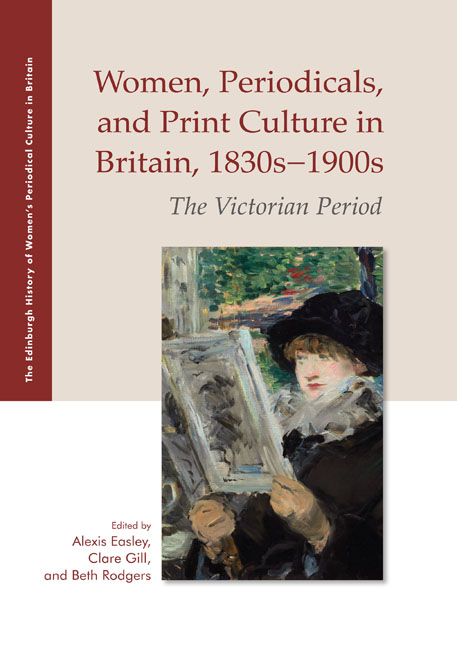Book contents
- Frontmatter
- Contents
- List of Illustrations
- Acknowledgments
- Introduction: Women, Periodicals, and Print Culture in the Victorian Period
- Part I (Re)Imagining Domestic Life
- Part II Constructing Modern Girls and Young Women
- Part III Women and Visual Culture
- Women and Visual Culture: Introduction
- 13 Vicarious Pleasures: Photography, Modernity, and Mid-Victorian Domestic Journalism
- 14 Beauty Advertising and Advice in the Queen and Woman
- 15 Women of the World: The Lady's Pictorial and Its Sister Papers
- 16 Rewriting Fairyland: Isabella Bird and the Spectacle of Nineteenth-Century Japan
- 17 Victorian Women Wood Engravers: The Case of Clemence Housman
- Part IV Making Space for Women
- Part V Constructing Women Readers and Writers
- Part VI Intervening in Political Debates
- Notes on Contributors
- Index
- Plate section
Women and Visual Culture: Introduction
from Part III - Women and Visual Culture
Published online by Cambridge University Press: 25 October 2019
- Frontmatter
- Contents
- List of Illustrations
- Acknowledgments
- Introduction: Women, Periodicals, and Print Culture in the Victorian Period
- Part I (Re)Imagining Domestic Life
- Part II Constructing Modern Girls and Young Women
- Part III Women and Visual Culture
- Women and Visual Culture: Introduction
- 13 Vicarious Pleasures: Photography, Modernity, and Mid-Victorian Domestic Journalism
- 14 Beauty Advertising and Advice in the Queen and Woman
- 15 Women of the World: The Lady's Pictorial and Its Sister Papers
- 16 Rewriting Fairyland: Isabella Bird and the Spectacle of Nineteenth-Century Japan
- 17 Victorian Women Wood Engravers: The Case of Clemence Housman
- Part IV Making Space for Women
- Part V Constructing Women Readers and Writers
- Part VI Intervening in Political Debates
- Notes on Contributors
- Index
- Plate section
Summary
WHEN THE FIRST ISSUE of the Illustrated London News appeared on 14 May 1842, it set the stage for the development of myriad forms of illustrated journalism that would become ubiquitous in popular print culture for the rest of the century. Illustrated newspapers and periodicals contributed to a broader visual culture which aimed to engage and construct a mass-market audience for print. From the very first, women were imagined as part of this ‘modern,’ largely urban audience. Indeed, the inaugural issue of the Illustrated London News not only included a brief column titled ‘The Fashions,’ accompanied by a fashion plate illustration, but also, two pages later, a portrait of Queen Victoria decked out in medieval attire for a costume ball at Buckingham Palace. The accompanying letterpress discussion of the fashion plate and Victoria's opulent costume suggested that women's apparel was interesting both as a spectacle of modern life and as an enticing category of commodities in an expanding consumer marketplace. The potent mixture of fashion, celebrity worship, and gender-specific ‘news’ fuelled the proliferation of illustrated content in a variety of forms, including domestic magazines, women's columns in popular newspapers, and advertisements selling everything from corsets to cosmetics. Within these intersecting modes of visual representation, women were defined as creators, consumers, celebrities, viewers, and spectacles.
The essays in this section address the many ways women were engaged with and represented by visual culture during the second half of the nineteenth century. The investigation begins at mid-century with Charlotte Boman's ‘Vicarious Pleasures: Photography, Modernity, and Mid-Victorian Domestic Journalism.’ Family magazines such as the Leisure Hour (1852–1905) and All the Year Round (1859–95) featured articles on the rise of new visual media technologies, linking them to domestic consumption and a rapidly shifting urban environment. Boman focuses specifically on the stereoscope, which became popular after being introduced to the public at the Great Exhibition (1851). Photography was a frequent topic of discussion in the mid-Victorian periodical press and played a key role in constructing the relationship between middle-class domesticity and the urban environment, demonstrating the ‘reciprocity between graphic and verbal culture and the resulting erosion of the private-public dichotomy’ (p. 216). Because women were so closely associated with privacy and domestic life, urban photography had the effect of unsettling conventional gender relations and destabilising the divide between public and private space.
- Type
- Chapter
- Information
- Women, Periodicals and Print Culture in Britain, 1830s–1900sThe Victorian Period, pp. 199 - 201Publisher: Edinburgh University PressPrint publication year: 2019



